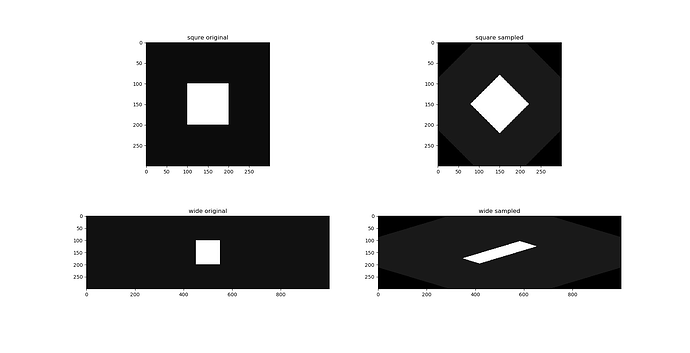Code to produce these results:
import torch
import torch.nn.functional as F
import imageio
def fill_center(img, s):
n, rows, cols = img.shape
s //= 2
c_row = rows // 2
c_col = cols // 2
img[:, c_row - s:c_row + s, c_col - s:c_col + s] = 1
return img
def rot_mat(angles):
coss = torch.cos(angles).unsqueeze(1)
sins = torch.sin(angles).unsqueeze(1)
rotations = torch.stack((torch.cat((coss, -sins), dim=1),
torch.cat((sins, coss), dim=1)), dim=2) # n_images, 2, 2
return rotations
shapes = [[300, 300], [300, 1000]]
names = ["square", "wide"]
n_images = 2
parameters = torch.zeros((n_images, 3))
parameters[1, 0] = 3.1415 / 4
for shape, name in zip(shapes, names):
orig_image = torch.zeros((1, *shape)) + 0.1
orig_image = fill_center(orig_image, 100)
orig_image = orig_image.expand(n_images, *orig_image.shape)
theta = torch.cat((rot_mat(parameters[:, 0]), parameters[:, 1:, None]), dim=-1)
scale = 1
n, c, rows, cols = orig_image.shape
sample_grid = F.affine_grid(theta, (n_images, 1, int(rows * scale), int(cols * scale)), align_corners=False).to(orig_image.device)
images = F.grid_sample(orig_image, sample_grid, align_corners=False)
images *= 255
images = images.permute(0, 2, 3, 1).to("cpu", torch.uint8)
for i in range(n_images):
imageio.imsave(f"{name}_{i:0>3}.jpg", images[i, ...])

